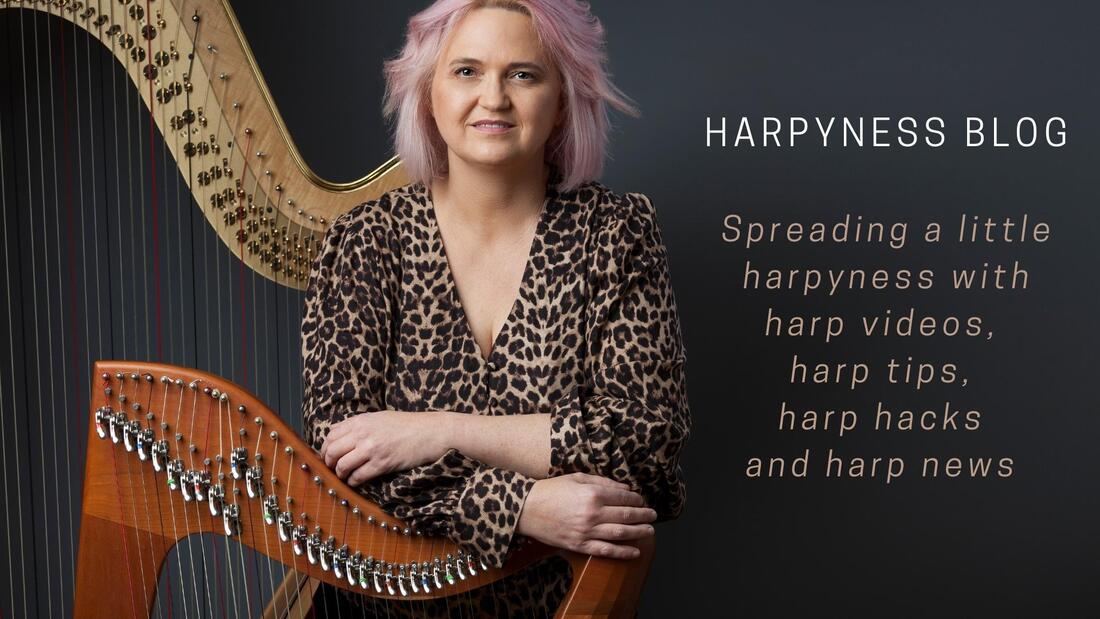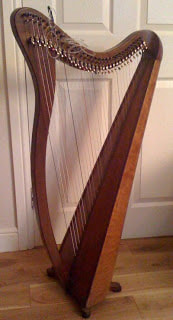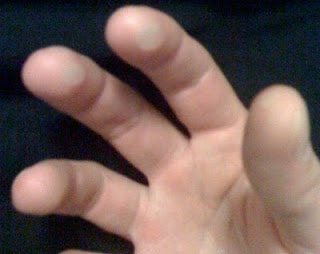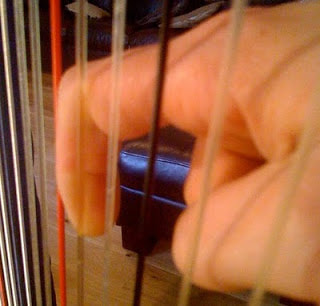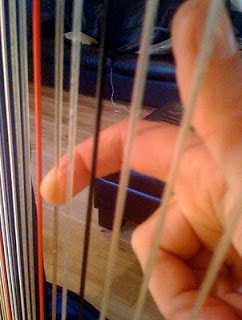|
Billy (aka The Harp Doctor) stopped over at mine recently when he travelled up to service my concert harps and as an unexpected bonus he unraveled the mystery of why my little clarsach was always so dodgy! It's a Wilfred Smith clarsach that I first started learning on as a child, and I now only use it on the odd occasion when teaching. Lots of sentimental value, but to be honest it's never been a great harp.
I never changed the strings as I was always worried that any change of tension would pull the soundboard straight out. So they were only ever changed when they broke, and most of those strings were over 35 years old! Billy had a good look at the strings and said that all the wrong tension strings were indeed on the harp and that I couldn't just put a new set of lever strings on as it would pull out the soundboard. So he changed the wires and I think as an extended Su-Duko type puzzle for himself in the evening he worked out what strings I should use for each note. I'm now half way through re-stringing and it's sounding pretty amazing. The tension is incredibly light and I do find it pretty hard to play as I am a Salvi girl and playing it is like ticking elastic bands. But WOW what a difference already. This harp originally had really awful blades and about 8 years ago I took it to Pilgrims for them to change the blades over to brass levers. They remembered this harp from their days when they were apprentices to Wilfred Smith, who was a very eccentric chap who had a very particular and unique take (and not necessarily the correct one) on how to make harps. Basically they learnt a lot of how "not to" with this harp. But amazingly enough this harp is still around and in a strange way it's the precursor to the Pilgrim Clarsach! Obviously I will need to paint in the C's and F's with red and black marker pen but the list is below. 1st A - gauge .58 - use 1st A lever nylon 1st G - gauge .58 - use 1st A lever nylon 1st F - gauge .60 - use 1st G lever nylon 2nd E - gauge .62 - use 1st B pedal nylon 2nd D - gauge .64 - use 1st B pedal nylon 2nd C - gauge .68 - use 2nd D lever nylon 2nd B - gauge .74 - use 2nd B lever nylon 2nd A - gauge .76 - use 2nd D pedal nylon 2nd G - gauge .76 - use 2nd D pedal nylon 2nd F - gauge .80 - use 2nd A lever nylon 3rd E - gauge .80 - use 2nd A lever nylon 3rd D - gauge .80 - use 2nd A lever nylon 3rd C - gauge .84 - use 2nd G lever nylon 3rd B - gauge .94 - use 3rd E lever nylon 3rd A - gauge .94 - use 3rd E lever nylon 3rd G - gauge .99 - use 3rd E pedal nylon 3rd F - gauge 1.05 - use 3rd B lever nylon 4th E - gauge 1.05 - use 3rd B lever nylon 4th D - gauge 1.14 - use 3rd G lever nylon 4th C - gauge 1.18 - use 4th E lever nylon 4th B - gauge 1.25 - use 4th D lever nylon 4th A - gauge 1.32 - use 4th B lever nylon 4th G - gauge 1.36 - use 4th A lever nylon 4th F - gauge 1.42 - use 4th F lever nylon 5th E - pirastro nycor wire 5th D - pirastro nycor wire 5th C - pirastro lever wire 5th B - pirastro lever wire 5th A - pirastro lever wire 5th G - pirastro lever wire 5th F - pirastro lever wire
0 Comments
so - what do you do? You are on a gig and you can't play on the blisters when they are really puffed up.
You can't play on the inner side of the finger tip because then the string is up against the puffed up blister when you play and gives off a really nasty pingy sound, and you are then so far away from normal playing position it's just weird. So that leaves playing on the outer side of the finger tip playing on just the very edge of the finger with the danger of constantly falling off the strings. I wouldn't mind but I have been practicing and gigging regularly so it's not like I've had days off from playing for them to get into this state. What the picture doesn't quite capture is just how puffed up and enormous they are! Somehow I managed to get through the gig yesterday. I have no idea how, especially as it was Karl Jenkins Requiem with it's very, very silly harp solo in the last movement! I'm not sure whether it's a peculiarity of the shape of my fingers, but over the years I have developed a technique for loud orchestral glisses when you just don't have time in the music to grab and use a felt pick. I can only do it with my 2nd finger (in both hands) so it only applies to upward glisses. Its using the whole side of the 2nd finger instead of the normal playing part of the finger tip. So the main part in contact with the string is the boney part just below the first finger joint.
I find I can get a very loud sound - not as loud as using picks but louder than the normal way of playing them, and most importantly I have complete control over the tone and dynamic. The down side though is that as well getting blisters on the finger in the normal playing position you also can end up with blisters on the side of your finger as well - so double the blisters on your 2nd fingers! I was playing Elgar's Dream of Gerontious on Saturday (with only 1 harp instead of 2) so by time I got to doing a childrens concert at the Phil the next morning my fingers were really sore. I didn't think there was going to be much for me to do in the childrens concert, but there was the usual thing of not getting the music until the day and finding a surprise harp cadenza right at the end of the concert! It was just a sort of extended flourish using glissandi but it was really useful using my odd gliss technique as my fingers were so sore. I really need to find a name for this technique! Went for run this morning and still finding it very hard work, but it's so nice to run and feel/see the sun after our sporadic winter running. Hopefully this bodes well for getting back into regular runs in the morning.
Just off for a quick tidy up and prune in the garden and then going to get ready for work later today at the Phil. It's a Stephen Sondheim birthday concert with Carl Davies. As per usual with these gigs the harp parts are disproportionally tricky and are not the nicest to sightread! I'm in more or less everything except Gershwin's "An American in Paris" which is being played WITHOUT the three saxophone parts. I didn't know there was a version without the saxes? There are three sax parts in the original score. I'm finding it hard to get back into a routine after having the worst cold I've had in YEARS.
It's been 3 weeks now and I'm still not back to full strength. Managed to go running this morning - more of a slow jog really, so at least thats an improvement. There is definitely a connection between whether I can get any physical exercise done and my productivity for the rest of the day. So here's hoping I manage to get a bit more done today then I have of late. I've just finished teaching, and must go and do some harp practice now. I think I will plough through the Salzedo Conditioning Exercises today as a technical work out. |
Categories
All
AuthorLauren Scott is a harpist & composer and has been blogging on Harpyness for over 10 years. If you enjoy reading Harpyness and you'd like to buy me a virtual coffee that would be very welcome. Cheers!
Archives
June 2024
|
